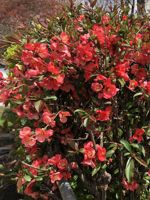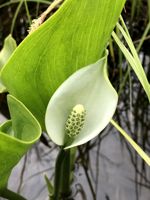Mon-Fri 9am - 5pm Mountain time
Japanese Quince vs Water Arum
Chaenomeles japonica
Calla palustris
NOT AVAILABLE THIS SEASON - MIGHT RETURN
CUSTOM GROW
Japanese Quince has bright, orange to red showy flowers that bloom in early spring. The flowers appear before the leaves and may continue to bloom after leaves emerge. Flowers grow on old wood, so pruning after flowering will help to promote new growth next spring. They produce yellow-green fruit that taste bitter when eaten raw, typically they are better suited for making preserves.
It can be used as a stand alone ornamental shrub, as a low hedge, or can be trained to grow against a wall. In late winter, branches of Japanese Quince can be cut and brought indoors where they will bloom on their own. They are deer and rabbit tolerant. The branches are spiny making them well suited for keeping unwanted wildlife away.
Water Arum is a native perennial wetland plant known for its showy white oval sheaths (spathe) that surround a yellow-green, cylindrical flower spike (spadix). It has large, oblong, heart-shaped leaves on stems that rise above the water from shallow, spreading rhizomes. The blossoms are followed in late summer by tiny, pear-shaped fruits that ripen to bright red, adding ornamental interest to wet habitats.
Water Arum provides food for birds and small mammals that eat its berries, and its flowers attract pollinators. It can tolerate cold climates and forms colonies in shallow water and saturated soils. It is well-suited for ecological restoration, riparian planting, naturalisation, and habitat projects in wet and shaded environments.
Japanese Quince Quick Facts
Water Arum Quick Facts
Toxicity: toxic if ingested

